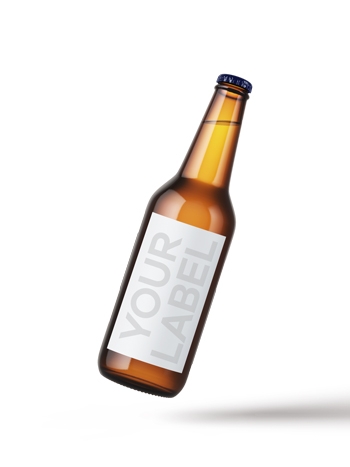Why Are Beer Bottles Brown?
Brown Beer Bottles: The Advantage Over Green & Clear Glass
Picture this: you’re enjoying a crisp beer at your favorite place, watching the light make your beer bottle glow a warm amber brown. Maybe you suspect the brown glass is a stylistic choice; after all, we often enjoy beer in green and clear beer bottles too.
However, brown glass, or amber glass, plays a critical role in maintaining the beer’s flavor. This is due to the degree of ultraviolet (UV) protection that it provides. By protecting your beer from harmful light, brown glass sets a standard that green and clear glass cannot match.


Striving for Freshness
As soon as it is packaged, the flavor of beer begins to change. Selecting the right type of container can help the brew maintain its chemistry as long as possible. Different beer bottle styles can have additional perks, such as higher pressure ratings.
In the United States, beer is rarely sold in plastic bottles since plastic does not hold carbonation as well as other materials do. Although cans are a great option for beer packaging, glass bottles provide a timeless appeal associated with sharper flavor. Some other benefits of glass packaging include its non-toxic nature, 100% recyclability, and presentable aesthetic.
The Effects of UV Light on a Beer’s Chemistry
A beer’s chemistry is determined by the relationship between its ingredients. These ingredients can be affected by outside factors, such as sunlight or fluorescent light, leading to unwanted chemical reactions that alter flavor. The unwanted chemical change caused by light is known as “skunking”.
What is “skunking”?
You may have heard bitter, floral beer described as “hoppy” after “hops”-- conical flowers of the Humulus lupulus plant in the hemp family. The majority of modern beer is brewed with hops, which release compounds during boiling (iso-humulones or iso-alpha acids). When exposed to UV light, these compounds break up and set off reactions with proteins that contain sulfur. The result is a new molecule with a skunk-like smell (3-MBT).
Skunking can happen very quickly. While skunked beer, also called “lightstruck” beer, is safe to drink, it will have an unappealing taste. To prevent skunking, we can protect our beer from sunlight much like we protect our skin with sunscreen.


The Benefits of Brown Beer Bottles


So why are beer bottles most commonly brown? Color-tinted glass provides UV protection by absorbing and blocking UV radiation. Brown, green, and clear beer bottles offer different amounts of protection. This is also true of other tinted glass options across industries, such as the debate between amber vs. cobalt blue glass containers.
The light wavelengths that cause beer to skunk measure around 350 to 550 nanometers. Brown glass provides protection from most wavelengths under 450 nm, which means it can protect against most but not all UV light. This makes beer bottles made of brown glass the ideal choice against skunking. However, it is still recommended to avoid keeping beer in direct sunlight for optimal freshness.
Why are Some Beer Bottles Green & Clear?
With brown glass providing the most UV protection, green and clear glass bottles may seem like poor alternatives. Many beer companies will use UV protectant coating on clear and green bottles, but even this cannot block light like brown glass does. The decision to use green and clear glass is largely a choice of aesthetic and marketing influenced by the brands’ histories.


Green Glass Bottles
During World War II, a high demand for brown glass led beer companies to use green bottles. Green glass provided more UV protection than clear bottles, generally blocking wavelengths under 370 nm but still allowing about 70% of light to pass through. Several companies kept their green glass look, making it a symbol of premium, European heritage brands. Examples of these are Heineken, Stella Artois, Peroni, Carlsberg, and Beck’s.


Clear Glass Bottles
The lack of UV protection on clear bottles may lead to slight changes in flavor, hence clear-bottled beer is often best paired with a slice of citrus fruit to cover up the skunkiness. Light beers– like Corona, Modelo, and Sol– are often marketed in clear bottles, highlighting their golden hues. They also tend to be served with limes.
Clear beer bottles are also frequently used for wine coolers, like Seagram’s Escapes, Smirnoff Ice, and Jack Daniel’s Country Cocktails. These do not undergo skunking.
How to Stand Out Among Brown Beer Bottles
With the iconic appearance of green beer bottles and transparent presentation of clear beer bottles, you may feel like creating a brand aesthetic means sacrificing UV protection. That is far from the truth!
Discovering the importance of label design will allow you to stand out among competitors, even in a sea of brown beer bottles. Explore beer bottle label design tips and beer bottle dimensions to create a one-of-a-kind label suited for the beer bottle style of your choice.
Whether you have an amazing design in your head or have no idea where to begin, our designers are here to help. We’ll create a mockup of your label before it’s printed so it looks exactly how you imagined. The Cary Company offers design services to make your dream bottle a reality.
Reach out to our creative team at 630.629.6600 or email sales@thecarycompany.com to schedule a free consultation to start the design process.






















